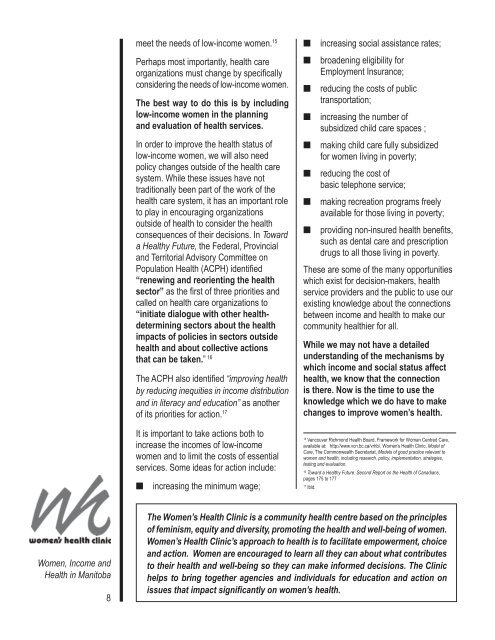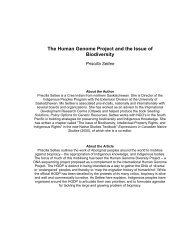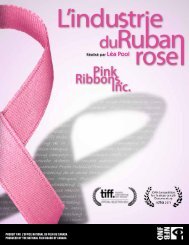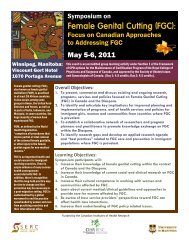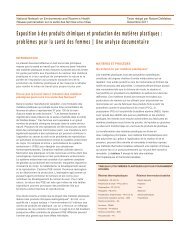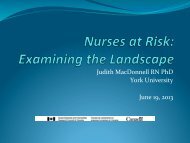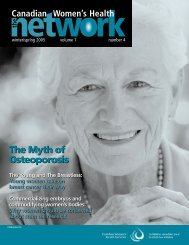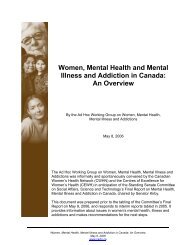here. - Canadian Women's Health Network
here. - Canadian Women's Health Network
here. - Canadian Women's Health Network
- No tags were found...
Create successful ePaper yourself
Turn your PDF publications into a flip-book with our unique Google optimized e-Paper software.
meet the needs of low-income women. 15Perhaps most importantly, health careorganizations must change by specificallyconsidering the needs of low-income women.The best way to do this is by includinglow-income women in the planningand evaluation of health services.In order to improve the health status oflow-income women, we will also needpolicy changes outside of the health caresystem. While these issues have nottraditionally been part of the work of thehealth care system, it has an important roleto play in encouraging organizationsoutside of health to consider the healthconsequences of their decisions. In Towarda <strong>Health</strong>y Future, the Federal, Provincialand Territorial Advisory Committee onPopulation <strong>Health</strong> (ACPH) identified“renewing and reorienting the healthsector” as the first of three priorities andcalled on health care organizations to“initiate dialogue with other healthdeterminingsectors about the healthimpacts of policies in sectors outsidehealth and about collective actionsthat can be taken.” 16The ACPH also identified “improving healthby reducing inequities in income distributionand in literacy and education” as anotherof its priorities for action. 17It is important to take actions both toincrease the incomes of low-incomewomen and to limit the costs of essentialservices. Some ideas for action include:■increasing the minimum wage;■■■■■■■■increasing social assistance rates;broadening eligibility forEmployment Insurance;reducing the costs of publictransportation;increasing the number ofsubsidized child care spaces ;making child care fully subsidizedfor women living in poverty;reducing the cost ofbasic telephone service;making recreation programs freelyavailable for those living in poverty;providing non-insured health benefits,such as dental care and prescriptiondrugs to all those living in poverty.These are some of the many opportunitieswhich exist for decision-makers, healthservice providers and the public to use ourexisting knowledge about the connectionsbetween income and health to make ourcommunity healthier for all.While we may not have a detailedunderstanding of the mechanisms bywhich income and social status affecthealth, we know that the connectionis t<strong>here</strong>. Now is the time to use theknowledge which we do have to makechanges to improve women’s health.15Vancouver Richmond <strong>Health</strong> Board, Framework for Woman Centred Care,available at: http://www.vcn.bc.ca/vrhb/, Women’s <strong>Health</strong> Clinic, Model ofCare, The Commonwealth Secretariat, Models of good practice relevant towomen and health, including research, policy, implementation, strategies,testing and evaluation.16Toward a <strong>Health</strong>y Future: Second Report on the <strong>Health</strong> of <strong>Canadian</strong>s,pages 175 to 17717Ibid.Women, Income and<strong>Health</strong> in Manitoba8The Women’s <strong>Health</strong> Clinic is a community health centre based on the principlesof feminism, equity and diversity, promoting the health and well-being of women.Women’s <strong>Health</strong> Clinic’s approach to health is to facilitate empowerment, choiceand action. Women are encouraged to learn all they can about what contributesto their health and well-being so they can make informed decisions. The Clinichelps to bring together agencies and individuals for education and action onissues that impact significantly on women’s health.


